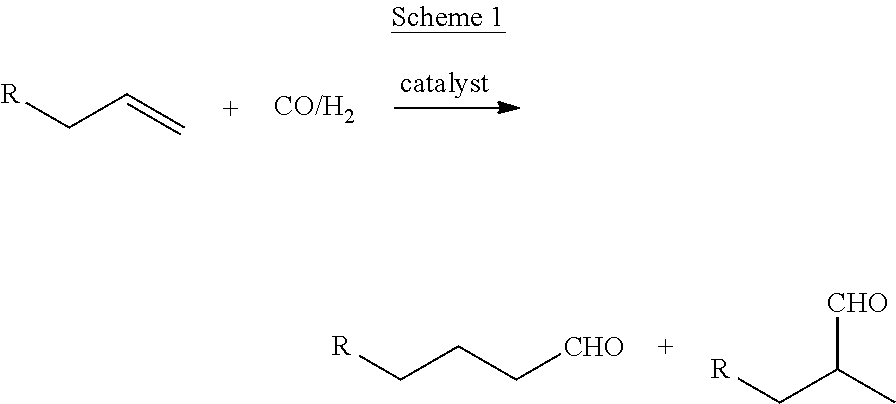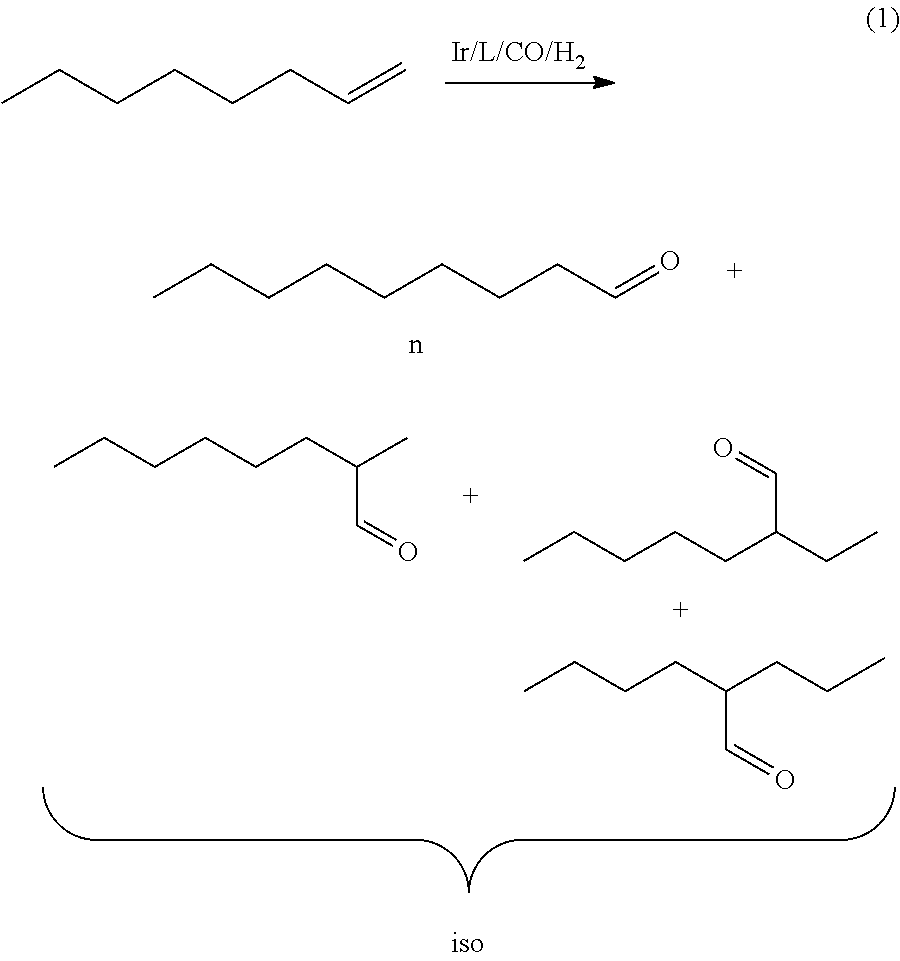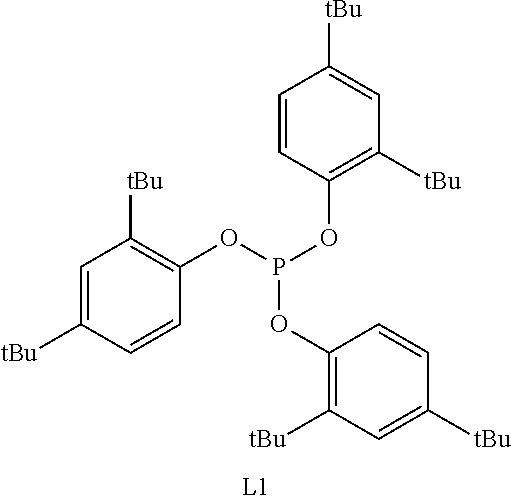Method for hydroformylation of unsaturated compounds
a technology of unsaturated compounds and hydroformylation methods, which is applied in the preparation of carbonyl compounds by oxidation, metal/metal-oxide/metal-hydroxide catalysts, physical/chemical process catalysts, etc., can solve the problems of inability to rationally predict the activity and selectivity of novel catalysts, and the comparatively expensive rhodium compounds are comparatively expensive noble metal complexes. , to achieve the effect of high catalyst productivity and selectivity ratio
- Summary
- Abstract
- Description
- Claims
- Application Information
AI Technical Summary
Benefits of technology
Problems solved by technology
Method used
Image
Examples
example 2
Table 1, Entry 2
[0047]10.2 mmol of 1-octene, Ir(cod)acac 0.2 mol % (8.1 mg), 0.44 mol % of PPh3 (11.8 mg) and 6 ml of THF under protective gas (e.g. argon or nitrogen) are transferred to a 25 ml stainless steel autoclave. The autoclave is heated to 100° C. and 4.0 MPa of synthesis gas (CO:H2=1:1) are injected at this temperature. The mixture is stirred for 16 h at this reaction pressure of 4.0 MPa.
[0048]Subsequently, the autoclave is cooled to room temperature and the residual pressure is released. 1 ml of isooctane is added to the reaction solution as an internal standard and the mixture is investigated by gas chromatography. The yield of nonanal is 69% with an n:iso ratio of 74:26. Moreover, 20% of octane is found as a hydrogenated starting substance.
example 3
Table 1, Entry 3
[0049]10.2 mmol of 1-octene, Ir(cod)acac 0.2 mol % (8.1 mg), 0.44 mol % of PPh3 (11.8 mg) and 6 ml of THF are transferred under protective gas (e.g. argon or nitrogen) to a 25 ml stainless steel autoclave. The autoclave is heated to 80° C. and 4.0 MPa of synthesis gas (CO:H2=1:1) are injected at this temperature. The mixture is stirred for 16 h at this reaction pressure of 4.0 MPa.
[0050]Subsequently, the autoclave is cooled to room temperature and the residual pressure is released. 1 ml of isooctane is added to the reaction solution as an internal standard and the mixture is investigated by gas chromatography. The yield of nonanal is 13% with an n:iso ratio of 75:25. Moreover, 3% of octane is found as hydrogenated starting substance.
example 4
Table 1, Entry 4
[0051]10.2 mmol of 1-octene, Ir(cod)acac 0.2 mol % (8.1 mg), 0.44 mol % of PPh3 (11.8 mg) and 6 ml of THF under protective gas (e.g. argon or nitrogen) are transferred to a 25 ml stainless steel autoclave. The autoclave is heated to 120° C. and 4.0 MPa of synthesis gas (CO:H2=1:1) are injected at this temperature. The mixture is stirred for 16 h at this reaction pressure of 4.0 MPa.
[0052]Subsequently, the autoclave is cooled to room temperature and the residual pressure is released. 1 ml of isooctane is added to the reaction solution as an internal standard and the mixture is investigated by gas chromatography. The yield of nonanal is 70% with an n:iso ratio of 71:29. Moreover, 29% of octane is found as hydrogenated starting substance.
PUM
| Property | Measurement | Unit |
|---|---|---|
| temperature | aaaaa | aaaaa |
| temperature | aaaaa | aaaaa |
| pressure | aaaaa | aaaaa |
Abstract
Description
Claims
Application Information
 Login to View More
Login to View More - R&D
- Intellectual Property
- Life Sciences
- Materials
- Tech Scout
- Unparalleled Data Quality
- Higher Quality Content
- 60% Fewer Hallucinations
Browse by: Latest US Patents, China's latest patents, Technical Efficacy Thesaurus, Application Domain, Technology Topic, Popular Technical Reports.
© 2025 PatSnap. All rights reserved.Legal|Privacy policy|Modern Slavery Act Transparency Statement|Sitemap|About US| Contact US: help@patsnap.com



